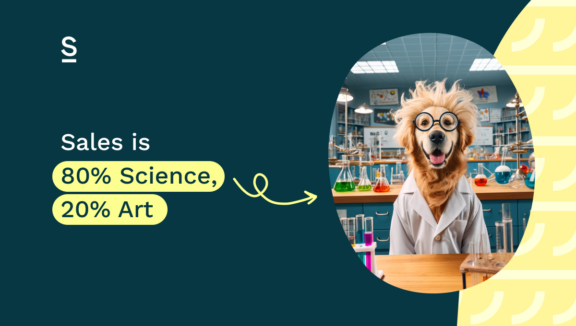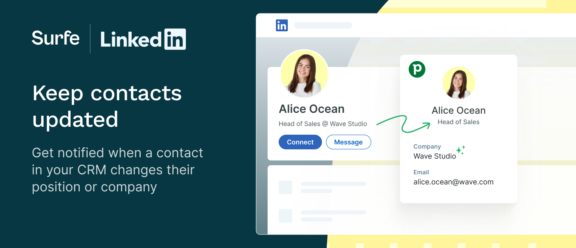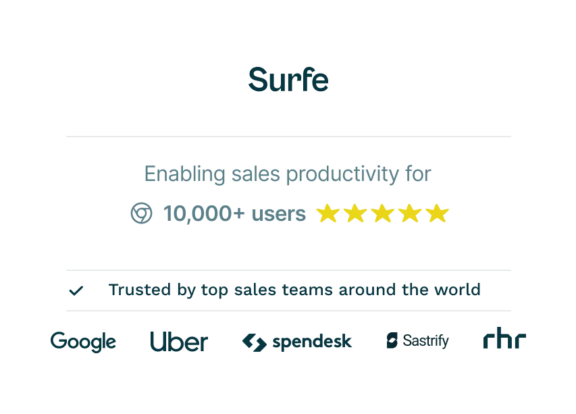Sales is 80% science, 20% art

“You must have the gift of the gab.”
“You’ve either got it or you don’t.”
“They just have a knack for it.”
As a sales professional, you’ve probably heard one or two of these during your career.
And sure, being a ‘natural salesperson’ isn’t going to hurt your work – but pretending talent is all you need to succeed does our profession a disservice.
The best salespeople are more like scientists. They rigorously analyze data, use a methodological approach and run experiments – then shake these in a test tube with some of the aforementioned charisma, uniqueness, nerve and talent.
Firms where salespeople use a methodology see 73% quota attainment. It’s a skill that should be honed over time – yet 55% of salespeople don’t have the basic capabilities needed to do so.
That’s where we come in. Pull on a white coat and goggles, and get ready to explore:
- Data is the DNA of sales
- Tools are scientific instruments
- Learning and experimentation
- The art of sales
See you in the lab.

Data is the DNA of sales
Just like DNA is the fundamental building block of life, data is the fundamental building block of modern sales strategies. Without it, sales efforts lack direction and precision – instead you’ll be throwing stuff at the wall to see what sticks.
Data analytics help you to understand your customers and identify trends in the market. You might keep track of how successfully you handle different objections to inform how you handle future ones. Or you might notice that deals that close the fastest tend to come from companies that have recently completed a funding round, which indicates who to target during outreach. Use these insights like these to inform your decisions, and you’ve got a data-driven approach.
Data analysis doesn’t have to be complicated or take up too much time. Rather, you should have the right equipment in your lab (or tech on your computer – you get the picture) to make it as easy as possible.
Let’s think about LinkedIn as an example. In the world of B2B sales, it’s likely that a huge amount of your data comes from there – but that doesn’t mean you have to spend hours upon hours scrolling your feed or combing through huge Sales Navigator lists. You can use tools to speed the data gathering and analysis up.
Connect LinkedIn to your CRM of choice with a tool like Surfe (hey 🙋) and you’ll have the data exactly where you need it. Surfe pulls what you need, like:
- Contact details
- Contact behavior – if they move jobs, for example
- What message and InMail templates are working well
And automatically feeds it through to your CRM for you to analyze. Data ready-made for you to work with? Yes please.

Tools are scientific instruments
Remember those lab tools we played around with earlier? Let’s talk more about them.
Precise instruments are key to accurate scientific results. Similarly, you need tools that deliver accurate data to improve your efficiency and outcomes.
These tools might look like:
- CRM systems: like HubSpot, Salesforce, and Pipedrive. CRM systems keep track of everything, from the nitty-gritty of each sales process to big-picture insights like pipeline coverage.
- Data enrichment tools: like Surfe, FullEnrich, and Lemlist. Data enrichment tools aggregate data providers to deliver accurate, up-to-date data for each prospect.
- Email finders: like Hunter, Apollo, and RocketReach. These are key for locating the tricky-to-find contact details of that perfect client.
When it comes to sales tools, the best of the best will work as hard for you as possible. Take Surfe. Yes, it offers data enrichment – but it also seamlessly integrates with your CRM and automatically populates and updates data where it needs to.
Automated functionality like this saves you time and makes you more efficient by proxy. It also reduces room for human error (no need to worry about emailing a prospect who’s moved to another company) which makes your activities more precise.
What Surfe does for salespeople is like what Penicillin does for pharmaceutical scientists, or what X-rays do for medics. It’s going to advance your skills and your work – and therefore your results – as quickly as possible.

Learn from the experts
Who’s heard of the ‘standing on the shoulders of giants’ metaphor? Basically, it’s the principle of gathering learnings and making progress over time by sharing knowledge with others.
Science advances by building on the work of previous experts – and sales professionals should learn from successful sales strategies and industry leaders. Build opportunities to learn into your days. Look at case studies, attend webinars and keep an eye out for networking opportunities. LinkedIn is another great resource; there are so many sales experts sharing their tips daily out there. You can pick up a lot from active company pages too.
How to Experiment and Iterate
Now we’re onto the fun part: the experiments. Like scientists, sales professionals must experiment with different strategies, analyse results and iterate based on their findings.
Experiments in sales might look like:
- A/B testing: which subject line gets a better open rate? Or which CTA gets a better response?
- Trialling new channels: maybe the secret lies in a specific combination of LinkedIn and email, maybe or you’ll have more luck meeting prospects at networking events
- Adjusting sales pitches: trying out a new way of demoing your product, or a different way of handling objections
Not every one of these experiments should be successful. It’s ok to be wrong sometimes. In fact, failures can be just as valuable to learn from as successes. If you’re able to detach from the outcome and view every action as an experiment, you’ll get comfortable taking bigger risks – and potentially gain better conversion rates and higher sales as a result. Either you win, or you learn.
This isn’t just a nice approach to have – it’s a necessity. The sales industry changes. If you stay doing the same thing all the time, you’re eventually going to get left behind.
Practice the Art of Sales
Let’s step out of the lab for a second. We’re sure you understand now that science is important when it comes to sales. The finishing touch is that artistic flair.
The art of sales is personal connection, empathy and creativity. It’s having a sense of when to listen, how to speak to your prospects on a unique level, and taking a fresh approach to problems.
The very best salespeople put a human approach at the centre of everything they do – even when working at scale. Use technology, like Surfe’s outreach templates, to help you here. Just like Renaissance painters used brushes to create their masterpieces, the modern-day salesperson uses tech to create theirs. You’re just creating an NFT rather than the Sistine chapel ceiling.
We hang art masterpieces on the walls for centuries, but pop culture celebrates sales too – just look at the success of The Big Short and the Wolf of Wall Street. Successful salespeople are revolutionary in their approach- and that’s what we should all be aiming for, no matter the size or the type of deal.
Let’s wrap it up!
The best salespeople are those who take a science-driven approach to their work – but that doesn’t mean you have to panic if it wasn’t your strong point at school.
Anyone can learn how to apply a scientific approach; prioritise data, invest in tools and tech to help you, run experiments and adopt a continuous learning mindset. Sprinkle in the human touch, and you’ve got a cocktail for success.
Take your gloves off and hang your coats up – the lab’s closed for the day!

Time to get experimental
Want to adopt a science-driven approach to your work? Surfe does half of the hard work for you by finding accurate data, automatically transferring it to your CRM and updating where needed. Plus, it’s got some sweet analysis skills too – all for free.


